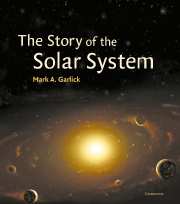Book contents
- Frontmatter
- Contents
- Miscellaneous Frontmatter
- Introduction
- Part 1 Genesis of the Sun and Solar Nebula
- Time zero: Giant Molecular Cloud
- 2 000 000 years: Solar Globule
- 2 030 000 years: Protosun
- 2 130 000 years: Solar Nebula
- 3 million years: T-Tauri Phase
- 3 million years: Outflow and Post-T-Tauri Phase
- 30–50 million years: The Main Sequence
- Part 2 Emergence of the Sun's Family
- Part 3 Solar System Past and Present
- Part 4 End of an Era
- Glossary
- Index
30–50 million years: The Main Sequence
from Part 1 - Genesis of the Sun and Solar Nebula
Published online by Cambridge University Press: 10 November 2009
- Frontmatter
- Contents
- Miscellaneous Frontmatter
- Introduction
- Part 1 Genesis of the Sun and Solar Nebula
- Time zero: Giant Molecular Cloud
- 2 000 000 years: Solar Globule
- 2 030 000 years: Protosun
- 2 130 000 years: Solar Nebula
- 3 million years: T-Tauri Phase
- 3 million years: Outflow and Post-T-Tauri Phase
- 30–50 million years: The Main Sequence
- Part 2 Emergence of the Sun's Family
- Part 3 Solar System Past and Present
- Part 4 End of an Era
- Glossary
- Index
Summary
At last, after a period of perhaps 30 to 50 million years – astronomers still cannot agree on their numbers – the Sun's contraction finally came to an end. Why? Because the Sun's internal temperature had reached an all-time high of 15 000 000 Celsius – and something had begun to happen to its supply of hydrogen.
Hydrogen is the simplest of all elements. Each atom contains just a single subatomic particle called a proton in its nucleus, positively charged. Orbiting this, meanwhile, is a single much smaller particle with exactly the opposite electric charge: an electron. Inside the Sun, these atoms are ionised: the electrons are detached and roam freely in the sea of hydrogen nuclei or protons. Very often, two of these hydrogen nuclei come together. Just as two magnetic poles of like polarity repel each other, so too do two protons. But not if they are brought together with sufficient speed. The speed of particles in a gas can be measured by the gas's temperature. And at 15 000 000 Celsius, the positively charged hydrogen nuclei at the Sun's core were now moving so quickly that when they smashed together they overcame their electrostatic repulsion, and fused as stronger nuclear forces took over. At last, the hydrogen was being consumed, gradually converted into helium in the Sun's core via a chain of nuclear reactions. Energy is a by-product of these reactions. And so the Sun now began to generate a significant amount of power in its core.
- Type
- Chapter
- Information
- The Story of the Solar System , pp. 22 - 23Publisher: Cambridge University PressPrint publication year: 2002



